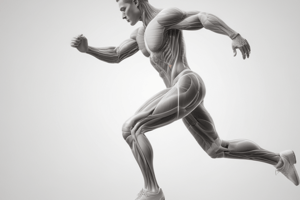Podcast
Questions and Answers
Which muscles are considered primary hip flexors?
Which muscles are considered primary hip flexors?
- Adductor brevis, gracilis, and anterior fibers of the gluteus minimus
- Iliopsoas, sartorius, tensor fasciae latae, rectus femoris, adductor longus, and pectineus (correct)
- Gluteus maximus, medius, and minimus
- Biceps femoris, semitendinosus, and semimembranosus
What is the function of the psoas major muscle?
What is the function of the psoas major muscle?
- Primary flexor and abductor of the hip
- Contributes to frontal plane stability to the lumbar spine (correct)
- Courses distally and medially across the thigh to attach on the medial surface of the proximal tibia
- Stabilizes the position of the underlying iliopsoas as it crosses the hip and anterior brim of the pelvis
Which muscle is responsible for transmitting a force around the thigh and between muscle groups?
Which muscle is responsible for transmitting a force around the thigh and between muscle groups?
- Iliopsoas
- Sartorius
- Tensor fasciae latae (correct)
- Adductor longus
What is the function of the intermuscular septa of the thigh?
What is the function of the intermuscular septa of the thigh?
What is the attachment point of the tensor fasciae latae?
What is the attachment point of the tensor fasciae latae?
Which muscle is responsible for one-third of the total isometric flexion torque at the hip?
Which muscle is responsible for one-third of the total isometric flexion torque at the hip?
What is the function of the reflected tendon of the rectus femoris?
What is the function of the reflected tendon of the rectus femoris?
Which muscle is described as a large bipennate-shaped muscle?
Which muscle is described as a large bipennate-shaped muscle?
Which muscle courses distally and medially across the thigh to attach on the medial surface of the proximal tibia?
Which muscle courses distally and medially across the thigh to attach on the medial surface of the proximal tibia?
Which muscle is not considered a primary hip flexor?
Which muscle is not considered a primary hip flexor?
Which muscle is a secondary hip flexor?
Which muscle is a secondary hip flexor?
Flashcards are hidden until you start studying
Study Notes
- The primary hip flexor muscles are the iliopsoas, sartorius, tensor fasciae latae, rectus femoris, adductor longus, and pectineus.
- Secondary hip flexors include the adductor brevis, gracilis, and anterior fibers of the gluteus minimus.
- The iliopsoas consists of two muscles: the iliacus and the psoas major.
- The psoas major contributes to frontal plane stability to the lumbar spine.
- The psoas minor may stabilize the position of the underlying iliopsoas as it crosses the hip and anterior brim of the pelvis.
- The sartorius muscle courses distally and medially across the thigh to attach on the medial surface of the proximal tibia.
- The tensor fasciae latae is a primary flexor and abductor of the hip.
- The fascia lata of the thigh turns inward between muscles, forming distinct fascial sheets known as intermuscular septa.
- The intermuscular septa of the thigh ultimately attach to the linea aspera on the posterior surface of the femur.
- Activation of the tensor fasciae latae can transmit a force around the thigh and between muscle groups.
- The tensor fascia lata is a muscle of the hip that attaches inferiorly through the iliotibial band.
- Repetitive tension within the iliotibial band may cause inflammation near the lateral tubercle of the tibia.
- Stretching maneuvers for a tightened tensor fascia lata are often performed with the knee extended and hip adduction and extension.
- The proximal part of the rectus femoris emerges between the sartorius and tensor fasciae latae.
- The rectus femoris has proximal attachments on the anterior-inferior iliac spine, superior rim of the acetabulum, and adjacent joint capsule.
- The reflected tendon of the rectus femoris is an important stabilizer of the anterior capsule.
- The rectus femoris attaches to the tibia via the patellar tendon and is responsible for one-third of the total isometric flexion torque at the hip.
- The rectus femoris is a primary knee extensor.
- The rectus femoris is a large bipennate-shaped muscle.
- The pectineus and adductor longus are described in the section on the adductors of the hip.
Studying That Suits You
Use AI to generate personalized quizzes and flashcards to suit your learning preferences.




